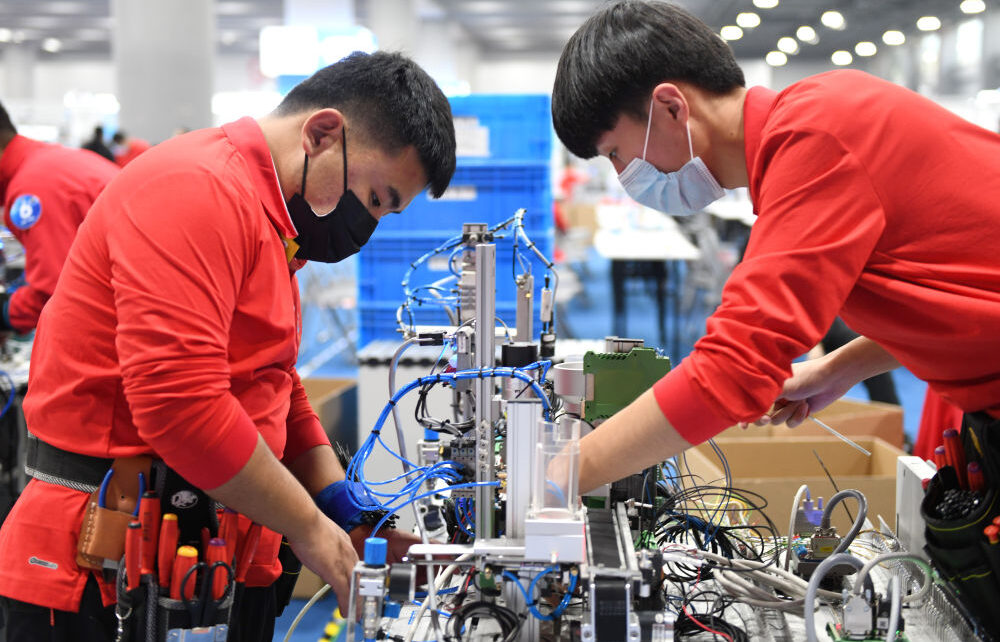Context: The growth rate of China’s employed population has been declining since 2015; in 2018, the growth rate became negative, and since has declined further. The unemployment rate was about 3.6 per cent in 2019, and it increased to around 3.8 per cent by the end of 2020. It is most likely to continue to increase in the foreseeable future. At the same time, there were 8.7 million new college graduates in 2020 (0.4 million more than in 2019) and the employment rate of new graduates was less than 40 per cent.
Implementation of programme/ initiative: Since May 2019, the Chinese government has been implementing a vocational skills training programme with a budget of RMB100 billion (USD15.5 billion). The programme aims to train new graduates and unemployed individuals in vocational skills, granting them sufficient qualifications to meet the current job market’s needs. The skills taught vary in different provinces, as local governments are responsible for developing their own training projects based on their specific requirements. This helps to efficiently address local unemployment. The programme plans to provide more than 50 million training opportunities, so trained workers can reach up to 25.0 per cent of China’s total employment population. The programme also aims for high-tech workers to reach 33.3 per cent of total trained workers in 2021. A majority of the courses are free or discounted for university students. Moreover, they are entirely free-of-charge for certain individuals such as persons with disabilities, those in poor households and veterans, while some projects may also provide basic living financial aid. The courses cover a variety of different fields, for example, cooking, Photoshop, electrical engineering and programming for artificial intelligence. The study time ranges from one month to one year. Registration and tuition fees are to be refunded as a subsidy after participants complete a course and receive their national vocational certification. An individual can take as many courses as they wish to, but they can only receive the subsidy three times in one year.
Main challenges: Participants are required to pay a registration fee when enrolling in a course, which acts as an incentive for them to finish it. However, participants only receive a refund if they pass the vocational proficiency test for the course, causing difficulty to those who wish to change their area of study. On the other hand, physical attendance and hands-on learning is essential for many of the courses taught. Due to the COVID-19 pandemic, many courses have been cancelled or moved online, leading to participants missing out on hands-on practice. Some participants do not even have the devices required to access the online courses.
Results achieved: At the end of 2019, there were 18.8 million enrolled individuals, including 2.6 million poor labourers, 1.4 million registered unemployed persons in urban areas and 1.0 million new college graduates. In order to increase the quality of teaching during the COVID-19 pandemic, the Chinese government has curated more than 50 high-quality online vocational skills training platforms, and launched digital training courses in more than 100 occupations. From January to August 2020, the government issued subsidies to individuals approximately 17 million times, benefitting more than 10 million participants.
Moving Forward: This programme is open to all Chinese citizens, and currently offers online courses. However, most of the physical courses take place in the provincial capital cities, causing challenges to participants who reside in other cities. In order to benefit more potential participants, the programme should further expand into other urban cities or rural areas where people lack educational resources. Furthermore, governments could cooperate with local companies to develop specific courses based on industry needs, and companies could offer permanent positions to participants after the training finishes.
Replicability: Countries with sufficient budgetary resources could replicate the model of this programme to cultivate more skilled workers. One of the advantages of this programme is its flexibility, as the local governments can develop their own courses to meet their specific needs. Another advantage is that high efficiency, concentrated and short-term learning allows participants to immediately fill shortages of specialized workers. In addition, it gives participants a second chance to start a new career, especially for youths who have not gone to college or vocational school.
Acknowledgement:
This good practice was kindly prepared by Ms. Juanying Xie.
References:
http://www.mohrss.gov.cn/SYrlzyhshbzb/dongtaixinwen/buneiyaowen/202005/t20200522_369496.html
Project Details
Date: January 22, 2021
